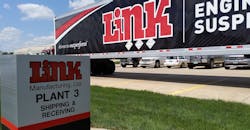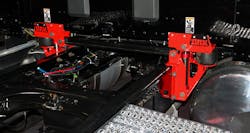Link’s ROI Cabmate aims to make driver’s ride smoother
SIOUX CENTER, IA — Link Manufacturing wants to make driving heavy-duty trucks a more stable ride for an unstable driver market. The company introduced its ROI Cabmate Semi-Active Cab Suspension on Tuesday, July 23, at a press conference held at its corporate offices here.
The newest and most advanced version of its Cabmate cab suspension features Link’s Road-Optimized Innovations (ROI) technology, delivering a new level of ride quality that responds to road and weather conditions.
In a trucking industry grappling with an unstable driver turnover rate, Link executives and engineers believe their new cab technology can help fleets retain and draw more drivers because the ROI can reduce the stress of bouncing around in a cab while driving across America’s bumpy roads.
“In 1980, the Cabmate premium cab suspension irrevocably improved safety and comfort in Class 7 and 8 cabs,” Jim Huls, president of Link Manufacturing told industry journalists. “Today we are the global leader in cab suspensions with our two-millionth Cabmate rolling off the assembly line this May. The new ROI Cabmate you are about to see will usher in a revolution in computer-controlled suspension systems for a variety of vehicle applications, and Link is leading that revolution.”
The ROI Cabmate Semi-Active Cab Suspension employs multiple sensors and is constantly assessing environmental circumstances while responding simultaneously. An accelerometer monitors the motion of the cab, while a position sensor measures the position and velocity of the cab relative to the frame.
Using Link’s proprietary algorithms, the system’s electronic control unit (ECU) interprets the stream of information from all sensors in real-time and responds by continuously adjusting the stiffness of shock absorbers and by filling or exhausting air from the system’s air springs to optimize ride stability and comfort. The entire ROI system operates on less than 10 watts of power.
“With Link’s ROI Cabmate, operators will enjoy the enhanced ride quality of a vehicle in a constant state of dynamic dampening,” said Michael Hof, vice president of new business development for Link. “With adjustments being made hundreds of times per second, the system can respond appropriately at each instant, thus drivers and passengers immediately have a very soft shock when traveling on a smooth highway, and a very stiff shock when driving on uneven or off-road terrain. The system deals with unexpected encounters, like potholes, in real-time.”
Link adjusts its system for each individual OEM tractor, such as Kenworth, Peterbilt, Navistar and Mack, Hof said, adding that while Link can’t control what OEMs would charge for the ROI, the company is trying to keep the cost below $2,000. It will also be available for retrofit on tractors already on the road.
After transitioning from on- to off-highway conditions, cabs can sustain structural damage, vehicles can become harder to handle and drivers can be forced to decrease speed to avoid losing control. Even at reduced speeds, operators may be exposed to dynamic forces that, according to ISO 2631-1:1997 standards, can cause internal injury over time. The ROI Cabmate Semi-Active Cab Suspension can help prevent health risks, handling impediments and asset destruction that decrease worker satisfaction, productivity and revenue potential.
Joel Morrow, head of research and development and senior driver for Ploger Transportation in Norwalk, OH, said the ROI is “going to have a major impact on the overall efficiency of our fleet and on the driver quality of life.”
He said that the suspension technology makes the truck drive better, which makes the driver happier, healthier and more productive. “When it comes to efficiency, some people may be scratching their head [and asking] how a cab suspension makes my truck more efficient,” Morrow said. “My truck rides better, I can shorten the wheelbases on my truck, I can close the gap between the truck and the trailer, which has a major impact on fuel efficiency. No. 1 expense of any fleet in the United States is fuel.”
In the past, Morrow said, the wheelbase would be stretched out so that a truck would ride better, which the drivers liked but “you’d end up with this huge gap between the truck and the trailer and it would just kill fuel-efficiency. So this is going to go a long way to allow me to optimize wheelbase, keeping the drivers happy with the ride quality and keeping fuel-efficiency high.
Morrow added that his stepson, who also drives for Ploger, got the first ROI test unit put into service. He “absolutely loves the thing” as he makes deliveris along the unsmooth roads of Chicago, Detroit, Philadelphia, the outer buroughs of New York City. “It definitly makes the tractor ride better,” he said.
Advanced seating has been used in the past to keep drivers more stable and to reduce discomfort. But that seating doesn’t prevent steering wheels, gear shifters and accelerator and brake pedals from moving with dynamic force around the driver. Structural components may also still be damaged, and the contents of the cab, including those occupying a sleeper compartment, are still at risk.
During the ROI Cabmate’s development, Link’s 39 years of cab suspension experience positioned it like no other to put the prototypes through their paces. Link is certified to IATF 16949 standards (previously TS16949).
The company assembled a testing lab here in northwest Iowa, where engineers measured the new suspension’s performance. The lab data collected indicated a significant improvement in all areas of quantifiable ride quality performance. While those differences could be examined by comparing the vehicle’s numerical ride characteristics, the qualitative differences, Link set its sights on logging a million miles of field-testing, using hardworking fleets and real-world conditions.
“As a family-owned, customer- and employee-focused corporation since 1920, we are always interested in learning about new technologies that can improve driver comfort, increase job satisfaction, promote safety and reduce maintenance costs,” said Gary Van Ekelenburg, director of equipment for C.R. England. “Like most fleets, we are very familiar with Link’s traditional Cabmate suspension, so field-testing Link’s new ROI Cabmate was a logical business decision and gave our drivers and our company a chance to experience the future of HD cab suspensions.”
The Cabmate Semi-Active Cab Suspension System also features electronic height control. The system minimizes air consumption compared to traditional height control valves because it does not fill or exhaust air in response to dynamic suspension motion. The system is designed to produce a better overall ride regardless of road surfaces and atmospheric forces, such as wind shear.
“Fleets will find numerous advantages associated with any vehicle fitted with Link’s Cabmate Semi-Active Cab Suspension System, beginning with protection of the driver and the whole-cab asset,” said Hof. “Reducing driver and vehicle fatigue and enhancing ergonomics may enable operators to traverse an uneven route more quickly and safely, enabling productivity to rise and additional runs to be made in a single shift. And what fleet or owner-operator doesn’t want that?”

